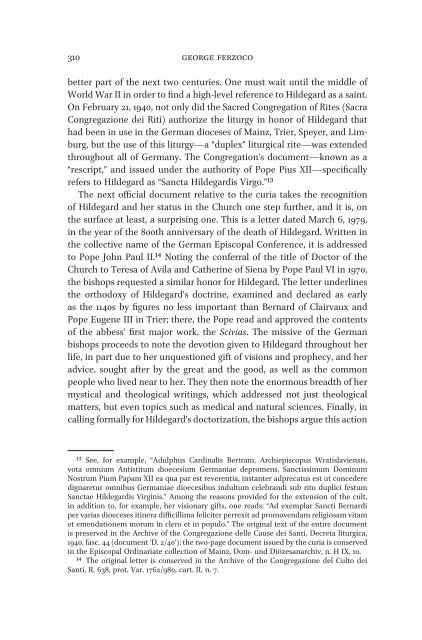A Companion to Hildegard of Bingen
Beverly Mayne Kienzle, Debra L. Stoudt & George Ferzoco, "A Companion to Hildegard of Bingen". BRILL, Leiden - Boston, 2014.
Beverly Mayne Kienzle, Debra L. Stoudt & George Ferzoco, "A Companion to Hildegard of Bingen". BRILL, Leiden - Boston, 2014.
- TAGS
- hildegard-of-bingen
Create successful ePaper yourself
Turn your PDF publications into a flip-book with our unique Google optimized e-Paper software.
310 george ferzoco<br />
better part <strong>of</strong> the next two centuries. One must wait until the middle <strong>of</strong><br />
World War II in order <strong>to</strong> fijind a high-level reference <strong>to</strong> <strong>Hildegard</strong> as a saint.<br />
On February 21, 1940, not only did the Sacred Congregation <strong>of</strong> Rites (Sacra<br />
Congregazione dei Riti) authorize the liturgy in honor <strong>of</strong> <strong>Hildegard</strong> that<br />
had been in use in the German dioceses <strong>of</strong> Mainz, Trier, Speyer, and Limburg,<br />
but the use <strong>of</strong> this liturgy—a “duplex” liturgical rite—was extended<br />
throughout all <strong>of</strong> Germany. The Congregation’s document—known as a<br />
“rescript,” and issued under the authority <strong>of</strong> Pope Pius XII—specifijically<br />
refers <strong>to</strong> <strong>Hildegard</strong> as “Sancta <strong>Hildegard</strong>is Virgo.”13<br />
The next <strong>of</strong>ffijicial document relative <strong>to</strong> the curia takes the recognition<br />
<strong>of</strong> <strong>Hildegard</strong> and her status in the Church one step further, and it is, on<br />
the surface at least, a surprising one. This is a letter dated March 6, 1979,<br />
in the year <strong>of</strong> the 800th anniversary <strong>of</strong> the death <strong>of</strong> <strong>Hildegard</strong>. Written in<br />
the collective name <strong>of</strong> the German Episcopal Conference, it is addressed<br />
<strong>to</strong> Pope John Paul II.14 Noting the conferral <strong>of</strong> the title <strong>of</strong> Doc<strong>to</strong>r <strong>of</strong> the<br />
Church <strong>to</strong> Teresa <strong>of</strong> Avila and Catherine <strong>of</strong> Siena by Pope Paul VI in 1970,<br />
the bishops requested a similar honor for <strong>Hildegard</strong>. The letter underlines<br />
the orthodoxy <strong>of</strong> <strong>Hildegard</strong>’s doctrine, examined and declared as early<br />
as the 1140s by fijigures no less important than Bernard <strong>of</strong> Clairvaux and<br />
Pope Eugene III in Trier; there, the Pope read and approved the contents<br />
<strong>of</strong> the abbess’ fijirst major work, the Scivias. The missive <strong>of</strong> the German<br />
bishops proceeds <strong>to</strong> note the devotion given <strong>to</strong> <strong>Hildegard</strong> throughout her<br />
life, in part due <strong>to</strong> her unquestioned gift <strong>of</strong> visions and prophecy, and her<br />
advice, sought after by the great and the good, as well as the common<br />
people who lived near <strong>to</strong> her. They then note the enormous breadth <strong>of</strong> her<br />
mystical and theological writings, which addressed not just theological<br />
matters, but even <strong>to</strong>pics such as medical and natural sciences. Finally, in<br />
calling formally for <strong>Hildegard</strong>’s doc<strong>to</strong>rization, the bishops argue this action<br />
13 See, for example, “Adulphus Cardinalis Bertram, Archiepiscopus Wratislaviensis,<br />
vota omnium Antistitum dioecesium Germaniae depromens, Sanctissimum Dominum<br />
Nostrum Pium Papam XII ea qua par est reverentia, instanter adprecatus est ut concedere<br />
dignaretur omnibus Germaniae dioecesibus indultum celebrandi sub ritu duplici festum<br />
Sanctae <strong>Hildegard</strong>is Virginis.” Among the reasons provided for the extension <strong>of</strong> the cult,<br />
in addition <strong>to</strong>, for example, her visionary gifts, one reads: “Ad exemplar Sancti Bernardi<br />
per varias dioeceses itinera difffijicillima feliciter perrexit ad promovendam religiosam vitam<br />
et emendationem morum in clero et in populo.” The original text <strong>of</strong> the entire document<br />
is preserved in the Archive <strong>of</strong> the Congregazione delle Cause dei Santi, Decreta liturgica,<br />
1940, fasc. 44 (document ‘D. 2/40’); the two-page document issued by the curia is conserved<br />
in the Episcopal Ordinariate collection <strong>of</strong> Mainz, Dom- und Diözesanarchiv, n. H IX, 10.<br />
14 The original letter is conserved in the Archive <strong>of</strong> the Congregazione del Cul<strong>to</strong> dei<br />
Santi, R. 638, prot. Var. 1762/980, cart. II, n. 7.
















